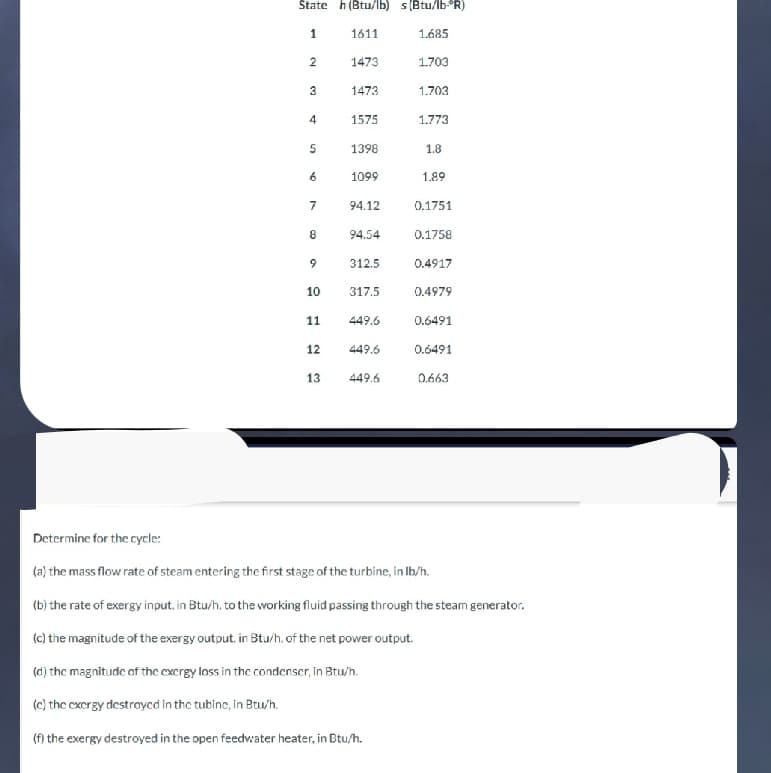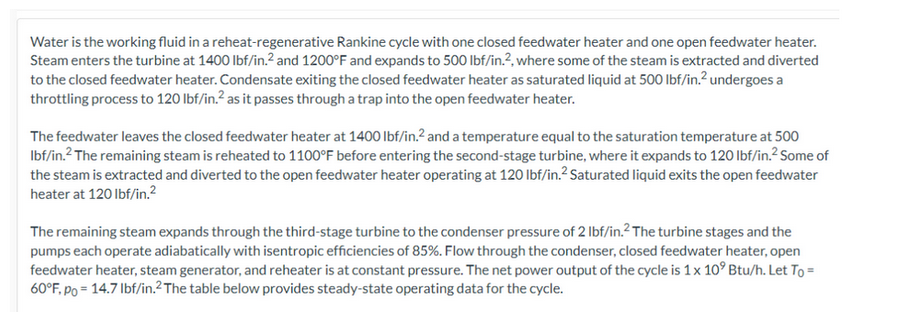Water is the working fluid in a reheat-regenerative Rankine cycle with one closed feedwater heater and one open feedwater heater. Steam enters the turbine at 1400 lbf/in.² and 1200°F and expands to 500 lbf/in.2, where some of the steam is extracted and diverted to the closed feedwater heater. Condensate exiting the closed feedwater heater as saturated liquid at 500 lbf/in.² undergoes a throttling process to 120 lbf/in.² as it passes through a trap into the open feedwater heater. The feedwater leaves the closed feedwater heater at 1400 lbf/in.2 and a temperature equal to the saturation temperature at 500 lbf/in.² The remaining steam is reheated to 1100°F before entering the second-stage turbine, where it expands to 120 lbf/in.² Some of the steam is extracted and diverted to the open feedwater heater operating at 120 lbf/in.² Saturated liquid exits the open feedwater heater at 120 lbf/in.² The remaining steam expands through the third-stage turbine to the condenser pressure of 2 lbf/in.² The turbine stages and the pumps each operate adiabatically with isentropic efficiencies of 85%. Flow through the condenser, closed feedwater heater, open feedwater heater, steam generator, and reheater is at constant pressure. The net power output of the cycle is 1 x 10° Btu/h. Let To = 60°F, po = 14.7 lbf/in.² The table below provides steady-state operating data for the cycle.
Water is the working fluid in a reheat-regenerative Rankine cycle with one closed feedwater heater and one open feedwater heater. Steam enters the turbine at 1400 lbf/in.² and 1200°F and expands to 500 lbf/in.2, where some of the steam is extracted and diverted to the closed feedwater heater. Condensate exiting the closed feedwater heater as saturated liquid at 500 lbf/in.² undergoes a throttling process to 120 lbf/in.² as it passes through a trap into the open feedwater heater. The feedwater leaves the closed feedwater heater at 1400 lbf/in.2 and a temperature equal to the saturation temperature at 500 lbf/in.² The remaining steam is reheated to 1100°F before entering the second-stage turbine, where it expands to 120 lbf/in.² Some of the steam is extracted and diverted to the open feedwater heater operating at 120 lbf/in.² Saturated liquid exits the open feedwater heater at 120 lbf/in.² The remaining steam expands through the third-stage turbine to the condenser pressure of 2 lbf/in.² The turbine stages and the pumps each operate adiabatically with isentropic efficiencies of 85%. Flow through the condenser, closed feedwater heater, open feedwater heater, steam generator, and reheater is at constant pressure. The net power output of the cycle is 1 x 10° Btu/h. Let To = 60°F, po = 14.7 lbf/in.² The table below provides steady-state operating data for the cycle.
Elements Of Electromagnetics
7th Edition
ISBN:9780190698614
Author:Sadiku, Matthew N. O.
Publisher:Sadiku, Matthew N. O.
ChapterMA: Math Assessment
Section: Chapter Questions
Problem 1.1MA
Related questions
Question

Transcribed Image Text:State h (Btu/lb) s (Btu/lb-R)
1
1611
2
3
4
5
6
7
8
9
10
11
12
13
1473
1473
1575
1398
1099
94.12
94.54
312.5
317.5
449.6
449.6
449.6
1.685
1.703
1.703
1.773
1.8
1.89
0.1751
0.1758
0.4917
0.4979
0.6491
0.6491
0.663
Determine for the cycle:
(a) the mass flow rate of steam entering the first stage of the turbine, in lb/h.
(b) the rate of exergy input, in Btu/h, to the working fluid passing through the steam generator.
(c) the magnitude of the exergy output. in Btu/h, of the net power output.
(d) the magnitude of the exergy loss in the condenser, in Btu/h.
(c) the exergy destroyed in the tubine, in Btu/h.
(f) the exergy destroyed in the open feedwater heater, in Btu/h.

Transcribed Image Text:Water is the working fluid in a reheat-regenerative Rankine cycle with one closed feedwater heater and one open feedwater heater.
Steam enters the turbine at 1400 lbf/in.² and 1200°F and expands to 500 lbf/in.2, where some of the steam is extracted and diverted
to the closed feedwater heater. Condensate exiting the closed feedwater heater as saturated liquid at 500 lbf/in.² undergoes a
throttling process to 120 lbf/in.² as it passes through a trap into the open feedwater heater.
The feedwater leaves the closed feedwater heater at 1400 lbf/in.2 and a temperature equal to the saturation temperature at 500
lbf/in.² The remaining steam is reheated to 1100°F before entering the second-stage turbine, where it expands to 120 lbf/in.² Some of
the steam is extracted and diverted to the open feedwater heater operating at 120 lbf/in.² Saturated liquid exits the open feedwater
heater at 120 lbf/in.²
The remaining steam expands through the third-stage turbine to the condenser pressure of 2 lbf/in.² The turbine stages and the
pumps each operate adiabatically with isentropic efficiencies of 85%. Flow through the condenser, closed feedwater heater, open
feedwater heater, steam generator, and reheater is at constant pressure. The net power output of the cycle is 1 x 10° Btu/h. Let To =
60°F, po = 14.7 lbf/in.² The table below provides steady-state operating data for the cycle.
Expert Solution
This question has been solved!
Explore an expertly crafted, step-by-step solution for a thorough understanding of key concepts.
Step by step
Solved in 5 steps with 5 images

Knowledge Booster
Learn more about
Need a deep-dive on the concept behind this application? Look no further. Learn more about this topic, mechanical-engineering and related others by exploring similar questions and additional content below.Recommended textbooks for you

Elements Of Electromagnetics
Mechanical Engineering
ISBN:
9780190698614
Author:
Sadiku, Matthew N. O.
Publisher:
Oxford University Press

Mechanics of Materials (10th Edition)
Mechanical Engineering
ISBN:
9780134319650
Author:
Russell C. Hibbeler
Publisher:
PEARSON

Thermodynamics: An Engineering Approach
Mechanical Engineering
ISBN:
9781259822674
Author:
Yunus A. Cengel Dr., Michael A. Boles
Publisher:
McGraw-Hill Education

Elements Of Electromagnetics
Mechanical Engineering
ISBN:
9780190698614
Author:
Sadiku, Matthew N. O.
Publisher:
Oxford University Press

Mechanics of Materials (10th Edition)
Mechanical Engineering
ISBN:
9780134319650
Author:
Russell C. Hibbeler
Publisher:
PEARSON

Thermodynamics: An Engineering Approach
Mechanical Engineering
ISBN:
9781259822674
Author:
Yunus A. Cengel Dr., Michael A. Boles
Publisher:
McGraw-Hill Education

Control Systems Engineering
Mechanical Engineering
ISBN:
9781118170519
Author:
Norman S. Nise
Publisher:
WILEY

Mechanics of Materials (MindTap Course List)
Mechanical Engineering
ISBN:
9781337093347
Author:
Barry J. Goodno, James M. Gere
Publisher:
Cengage Learning

Engineering Mechanics: Statics
Mechanical Engineering
ISBN:
9781118807330
Author:
James L. Meriam, L. G. Kraige, J. N. Bolton
Publisher:
WILEY